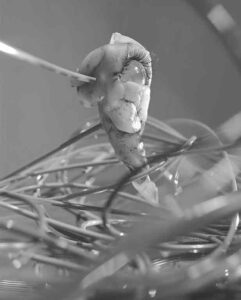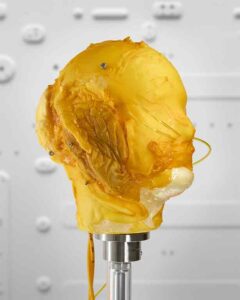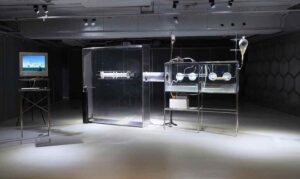Minwen Wang
Scientific progress can be controversial, especially when it comes to our bodies. The genetic modification of organisms, including our future selves, is a particularly sensitive issue that tends to grab headlines. Bio-scientific development can cause public alarm because for many people it strikes at our fundamental assumptions of personhood, religion and ethics. And while we benefit from such advances – in medicine for example – it can also seem threatening to our understanding of our place in the world. Human curiosity ensures that new discoveries are inevitable and with that comes a fear of the unknown. It may change us before we really know what ‘us’ means. Contemporary art has become one of the most dynamic crucibles for discoursing this dilemma.

Art that experiments with the processes that sustain life became known as BioArt, a term coined by Brazilian artist Eduardo Kac in 1997. The emergence of BioArt not only brought artists into dialog with existing tensions in the field of science, it ignited a further round of debate over the relationship between scientific and artistic experimentation.
In 2000, Kac (working with French genetic scientist, Louis-Marie Houdebine) produced his notorious GFP (green fluorescent protein) bunny named Alba – a transgenic rabbit that radiated green luminescence. Predictably Kac was tagged as the proverbial mad scientist – a progenitor of new lifeforms, and scandal ensued. Aside from some observers’ consternation about the rabbit, there was also anxiety about whether artists’ creative readings of the facts, mathematics and physics behind biotechnology might undermine the public’s understanding of a very complicated subject.
Victimless Leather (2004) is another example of artists interpreting what life can mean. Created by Oron Catts and Ionat Zurr—as Tissue Culture & Art Project – the artwork consisted of a small meat jacket (formed in a bioreactor womb) born from human and mouse stem-cells which could continue to grow – given certain nutritional intake. The work was in part intended to address animal abuse in clothing manufacturing by creating a consumer product without harming or killing animals, using collections of cells rather than whole organisms that are so often kept in dreadful conditions – think minks and geese.
However, when the work was exhibited in Design and the Elastic Mind at New York’s Museum of Modern Art in 2008, there was an unexpected, and rather grim, incident more commonly associated with science fiction horror. The curator, Paola Antonelli, elected to have the jacket’s food supply stopped because it began to expand far more quickly than had been anticipated. Some wondered if this act had ended the jacket’s life. The incident increased the project’s profile and fomented further concern regarding the potential outcomes and complications of using engineered tissue and how to manage or care for it. Do such products have rights? What are our responsibilities in creating and raising them? These questions move beyond ethics and into our daily lives and even into our wardrobes.
Scientific research can bring benefits, but economic gain for the most powerful industrial stakeholders is undoubtedly a major factor. It is vital to examine how we have been shaped mentally and physically by commerce, clinical technologies and for-profit conglomerates. Wherever fantastic sums of money are involved, public skepticism naturally increases, muddying the balance between improving human living conditions and environmental and social considerations. Matters of conscience regarding human interference in natural law and evolution are also important factors.

Taking a different approach, Critical Art Ensemble comprises a group of artists who investigate the political, human and economic impacts (and dangers) behind bioscience and technology, and how field discoveries can be manipulated by governments, industrial manufacturers, and capitalist enterprises. CAE’s performative work Flesh Machine (1997-98) involved profiling volunteers’ genetic make-up as part of an examination of the history, legacy, politics, moral issues, and discriminatory concerns of eugenics. They also considered its possible future use and the grave implications of selecting or creating desirable bodies, and how such practices can be exploited and monetized for cultural or political gain. Their aim generally has been to challenge authoritarianism and government overreach; and to reflect critically on the human, societal and environmental risks of financial or state control in biotechnologies. Critical Art Ensemble can be considered BioArt activists tolling the bell against corporate greed, political dominion, and the nefarious efforts of companies and regimes to consolidate power by harvesting or altering fundamental aspects of humanity and collective behaviors for profit.
As scientific subjects reach further into our lives, art continues responding and flourishing. The combined beauty and potential of art and science dissolves some of the boundaries between them and sets the stage for marvelous experiments and possibilities. An increasing number of artists are engaging poetically with biotechnological themes and their sociological effects and potential, through new and traditional media.
Terrance James Jr is a Brooklyn-based artist who uses photography, sculpture and installation to investigate the mysteries and consequences of biotechnology, genetic engineering, and their effects on human physiology, racial inequality, socio-politics and the environment. Influenced by science-fiction classics including Ridley Scott’s Alien (1979), and Octavia E. Butler’s Lilith’s Brood (1987-1989), James’ figurative works juxtapose the horror and beauty that can manifest in material change and decomposition, stoking our fears and hopes about industrial and technological progress. James taps into a rich historical seam that connects with the dark romance and imaginative qualities of Bram Stoker, Edgar Allen Poe and H.P. Lovecraft which so often compensate when our knowledge reaches its limits. The artist’s themes of interest are reflected materially. By mimicking the texture of human flesh using artificial products, James raises the prospect of transformation between inanimate objects and living material.

James’ practice draws on his experiences as an African American by reflecting on themes of alienation and difference (hallmarks of science-fiction and very real human subjugation) and considering how 400 years of systemic racism and institutional prejudice have been used to disenfranchise and harm Black people. James’ thoughtful use of color, and its absence, subtly alludes to cultural context, and geopolitical narratives that influence interpretations of the meanings of colors. In Achromatic (2015-20) and Quantum Corpus: Panspermia (2020) James restricts the materials and palette to grayscale so that the biomorphic sculptures allude to polemics of black and white, while cleverly hinting at the common phrases ‘gray area’ and ‘gray matter’ to denote respectively, a subject that is unresolved or undefined, and the function of intellect and the brain. James states: “I’m interested in the social construct of race, biodiversity, and the implications that pseudosciences have had on society. My colorful palettes are a way to explore the politics of color. The color Black for instance, it implies very different things depending on context, country, culture etc. It’s the same with White. The introduction of vibrant colors is similar. There’s this book, Chromophobia, by David Batchelor. That breaks down color and the fear of color; corruption from a western perspective, the book breaks down color theory, history, etc. in short, I use vibrant colors to examine otherness.”
James’ interests extend to the detrimental effects of environmental damage, climate change and ecological disaster, particularly on society’s most vulnerable groups. This implicates scientists, geneticists, social engineers and civic planners in the detriments and safety of those most at risk from inadequate living conditions, exacerbated by natural phenomena and human mismanagement—too often poorer and marginalized communities of color that are frequently moved to the social, economic and geographic peripheries. Furthermore, biological challenges such as the Covid pandemic have exposed yawning gaps in medical care, access and support between the very richest and the majority. The artist states:
“I began to examine bioengineering as a means of resistance. Taking into account the pharmaceutical industrial complex, environmental racism, and human experimentation, I built a practice around speculative biology.”
Ting-Tong Chang, a London-based Taiwanese artist, often collaborates with scientists to create ink drawings, durational performances and kinetic sculptures. Chang’s installations attempt to convey a unique sense of time and space allowing viewers to see scientific processes in action and be immersed in them.
Chang’s installation Second Life: Habitat (2016) consisted of breeding chambers for eight-thousand Asian Tiger Mosquitos and an accompanying computer system. The mosquitos lived their entire life cycles in the chambers. The death of each mosquito generated a virtual human avatar through electrical signals that could be operated by visitors using the computer. After a ten hour lifespan the termination of each avatar released Chang’s blood into the machine to breed a new generation of mosquitos.

If, as the first law of thermodynamics claims, energy can’t be created or destroyed, only changed from one form into another, does this mean that our energy will transfer to other things, even the intangible soul, mind or spirit? Will our lives have a second chance in the virtual world like the mosquitos, and can our essences interact with other forms of life? Will that process be controlled by ourselves, an alien civilization, or a universal creator? While Chang’s work explored the interaction between virtual and real life, his environmental intention was to note global warming’s effect on the increasing prevalence of zoonotic diseases transmitted to humans from blood-hungry arthropods. For another installation titled Ten Thousand Spirits (2019) Chang worked with a Korean shaman and a bioscientist to construct an installation which combined the features of a temple and a machine that contains makgeolli—a sacred rice wine used in shaman worship rituals, manually produced by the shaman. Named Human Makgeolli, it was produced with bacteria from the shaman’s hand through scientific methods. Although many people believe that such customs amount to little more than superstition, there are still many who practice these traditions. Chang states:
“In Korea, the figure of the shaman stands out as the one who bridges the moral and spirit worlds. Shamans are entrusted with the ability to communicate with nature spirits, ancestors, or a culture’s gods and goddesses. They function variously as oracle, doctor, psychotherapist and other roles.”

Ten Thousand Spirits aimed to link science and witchcraft, which can be considered extremes on the spectrum of knowledge—or belief. It offers audiences an ancient, mysterious dream where the shaman’s spirituality faces science; and where past, present and future are connected. One cannot define easily if the Human Makgeolli is a scientific creation or a religious one. The artwork provides a space to reflect on history, and on how both religion and science have influenced human cultures and societies through millennia. Have some aspects of religion shed their founding principles – their skins – and become scientific? Will science bring more studies in the future which will resonate with and find common ground with ancient religious beliefs? We may not yet have answers to these questions but we can have a peek, through Chang’s work, at some possible outcomes.
When we observe and engage in wonderful and searching investigations as these artists have, we begin to ask important questions. In turn we gain confidence and empowerment that can assuage our fears. Their sensitivities and inventiveness, along with that of many other artistic thinkers working at the vanguard, provide previously unimagined prospects and new modes of thinking. Such creativity does not exclusively belong to art. It also exists in scientific curiosity. The union of science and art involves breaking boundaries, forging connections—sometimes terrifying and magnificent combinations—and suggesting pathways forward. The hope must be that these inquiries can help us fight against destructive hierarchies, economic divisiveness and racial prejudice. If we accept the responsibility of committed exploration, the union of art and science can lead us to greater understanding between cultures, expanded knowledge, and the tools to build more equitable futures.
Minwen Wang is a curator, designer and art writer. She received her Master of Fine Art in Curatorial Practice at Maryland Institute College of Art, Baltimore, in 2020. Wang has worked with various art institutions, including The National Art Museum of China. She is passionate about SciArt, online curating and public engagement, as well as supporting artists to convey their ideas in uplifting cross-cultural spaces.
Volume 35 no 4 March/April 2021
